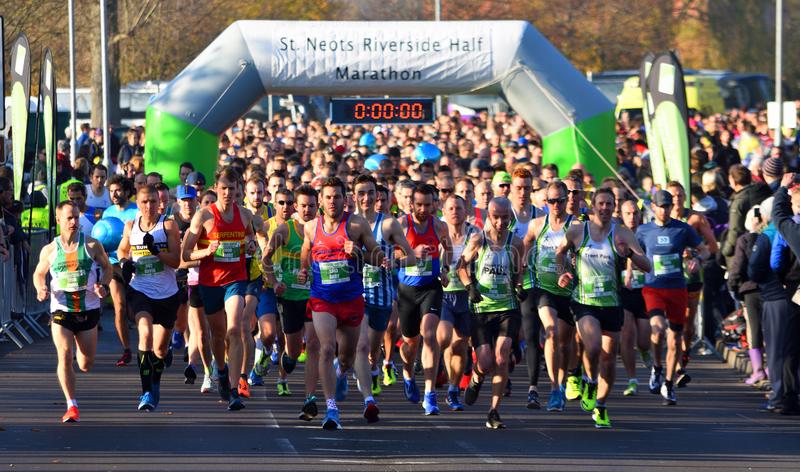Completing your first (or tenth!) 13.2 race with a smile is not impossible – just follow this half marathon training for beginners and
Just follow these 7 steps and you’ll finish your next half marathon with a happy runner’s high!
Why Run a Half Marathon?
Running a half marathon delivers the same thrill as running a marathon. But with less pain.
I’m kidding, kind of, but really – 13.2 miles is a significant running achievement. Taking the leap to run your first half marathon takes courage, dedication, and careful training and planning. It’s nothing to sneeze at.
So why run a half? Well, maybe you’ve run 5K’s, some 10K’s…maybe even a 10 Miler? And you want to push yourself to the next level, but aren’t ready (or never will be ready, like me) for a full marathon.
You want another doable challenge to get psyched about. Hang another running medal on the wall…with a shiny new high-mileage number attached to it.
In short, the half marathon is a great way to chase the runners high to another level and crush it. So, without further ado, read on and I’ll explain EXACTLY how to run your first half marathon!
1.) Pick a Goal
You can’t start training without a goal. It can be a simple goal, but you have to choose something concrete. Saying “I want to maybe start to train for a half marathon” is not good enough. It’s wishy-washy, and you probably won’t complete training this way. It gives you an out. Instead, make your goal S.M.A.R.T. – which stands for Specific, Measurable, Agreed-Upon, Realistic, and Time-Based.
(I think this is approach is intended for goal-setting in the business world but it totally applies to running too).
Here’s a perfect example of a S.M.A.R.T. half marathon goal:
“I am going to run the Bermuda Half Marathon on May 24th and I will finish the race in under 3 hours.” It’s specific (you picked a race and a time to hit). It’s measurable (finish in under 3 hours). It’s realistic (if you said under 1 hour that would be a different story,
2.) Select a Half Marathon Training Schedule for Beginners
Now you have a goal to works towards and need a half marathon training schedule to support it.
There are many variations of schedules, that range from simple beginners schedules to get you across the finish line, all the way to advanced runners schedules to hit a 6-minute-per-mile pace.
Choose wisely. Choose a beginner’s training plan that isn’t over-complicated.
Look for these 4 things in any good half marathon training for beginners:
- Long Runs (1 per week)
- Cross Training days (at least 1 per week) (read all about cross training for runners here)
- Easy/Recovery Runs (1-2 per week)
- Rest Day or Days (at least 1 per week)
How many weeks should my training schedule be?
Depends. How many weeks are there until the half marathon you want to run?
If You Can Run 3 Miles: I recommend a 12-week program if you can currently run at least 3 miles.
If You Can Run 1-2 Miles: If you aren’t up to 3 miles yet, but are running 1-2, go for a 16-week training program.
3.) Prepare to Train:
As my running mate always says: preparation is the key to success in life.
Preparing to train is important because, without preparation, training can be harder than it needs to be.
Things to Prepare You for Half Marathon Training for Beginners: The Right Running Gear – I outline essential running gear for beginners here, which covers a lot, but half marathon training requires a few additional items like:
Water bottle holder or CamelBak to stay hydrated on long runs
An extra pair of running shoes (as a backup, plus make sure to replace shoes after 250-300 miles)
Definitely need good performance socks Foam rollerAdjust Schedule if Needed – Account for any unavoidable plans by swapping days on the schedule ahead of time. If you absolutely have to miss a run completely, miss an easy run or cross-training day, but never a long run.
4.) Know What to Expect During Training
I wasn’t prepared for some aspects of half marathon training because I didn’t have half marathoners in my life to talk to. In retrospect, I should have done more research – but luckily for you, you found this post!
One of those things was proper long-run fuel. For any run over 45 or 60 minutes, you’ll want to bring fuel (snacks) along.
Here are some things to consider, and expect, during training:
- Experiment with Long Run Fuel – I prefer GU energy gels but some runners can’t stand them. Point is, It’s important to plan ahead and test what foods work for your stomach and body during training runs. Don’t wait until race day!
- Blisters and Chafing – You’ll likely get a blister. Or chafe. There are ways to try to prevent this (Aquaphor and Body Glide are your best friends) but inevitably it will happen. Expect it, deal with it, learn from it, and move on.
- Prepare for Weather Conditions – Depending on your climate and the time of year, you may have to run in very hot or very cold weather. Know what gear and time of day you need to run and prepare for it. You can’t let the weather get in your way! (Learn what hot weather gear you need and what cold-weather gear you need)
- Lack of Motivation – at some point, you’ll get tired. Or frustrated. Or distracted. Or all those things. Finding your method of motivation early will help you power through these times. Remember why you’re training and how amazing it will feel to accomplish your goal.
- Know When to Rest & Listen to Your Body – However, sometimes your body is telling you it needs rest. And you should listen. It’s not the end of the world if you miss a day or two of training. Pushing through when your body isn’t OK only leads to injury. Rest when you need rest.
- A rollercoaster of Emotions – I almost didn’t put this one but I have to be honest…on days when I have a great run, I feel so motivated and happy about my half marathon training. Then…on bad days…I can get overwhelmed or frustrated or mad at myself and the training. Maybe you’re different, but expecting this helps me to deal with the bad days knowing the crappy feelings will pass. Don’t cave in to the bad days. You DO want to achieve your goal and complete the race, and it will be worth it…you will barely remember the bad days, but will bask in the glory of half marathon completion for the rest of your life.
Knowing what to expect is SO important to successful training. Hopefully, this list is helpful to you!
5.) Pre-Race Prep

Write a checklist (or print this one) of all the things you need before, during, and after the race.
You won’t regret taking this extra step…don’t risk forgetting something important on race day!
Here are some big-hit items to double-check:
- Make sure your race day clothes are clean and ready to go.
- Your phone is charged and playlist is ready.
- Know the running route but also know how to get to the race location and any parking instructions.
- Prep or buy your during-race fuel
- Check your running shoes and bring a backup pair just in case
- Get your bib and race packet in advance if possible
Again, preparation is key! Running a half marathon is hard enough, don’t let missed details get in the way of success.
6.) Know What to Expect During the Race

First off, let’s be real about something – standing around waiting for the race to start is nerve-wracking.
But once you cross the starting line, you’ll be in the zone. And ready to rock.
Cheering crowds will boost your energy and distract you (in a good way) with encouragement.
If you need a bathroom break, don’t worry – almost all half marathons have porta-potties along the route (check this out ahead of time if you’re concerned though).
Look forward to planned fuel during the race (read: snacks). I know I do…basically my life centers around when I can eat snacks haha.
This breaks the run-up into mini-goals for me: 45 minutes in, I get a GU. Then another 45 minutes later, another GU! Bonus: my second GU has caffeine…weeeeee! And so on.
Many people start to feel tired around Mile 10 or 11. Push through it.
Immediately After Finishing: Drink water or a sports drink like Gatorade and eat something immediately after the race.
Most half marathons have a wealth of food situated around the finish line. Grab a bagel with peanut butter and a banana. Or whatever floats your boat.
Keep Moving: Also, don’t sit down right away. Muscles may cramp up…keep walking around for a bit to properly cool down. Then make sure to stretch really well to alleviate muscle tightness later.
Take Some
Later in the Day, and Days Following – The foam roller is your friend – read The Ultimate Guide to Foam Rolling for Runners. Your legs will be sore (you ran a half marathon!), and foam rolling helps loosen tight muscles. Bonus tip: post-half-marathon is a GREAT reason to book a massage! It aids in recovery, plus, you deserve a treat for all that hard work!
Hydrate – drink plenty of water in the days following a half marathon to replenish.
Eat Right: You’re going to be hungry after a half marathon. But be cautious of post-half-marathon binge-eating. It won’t help your body heal. Obviously, a treat or two won’t hurt anything, but keep moderation in mind.
Now you’re ready for your first half marathon!
About

Hi, I am Rene Welcome to Run Professor, where runners learn how to crush their goals!
I believe everyone can find joy in running, whether you’re “athletic” or not, and I’ll provide you with the tools you need to excel in your running journey (no matter what stage you’re at).
Glad you’re here! 🙂
Affiliate disclosure occasionally includes affiliate links in our posts or pages. What does this mean to you? If you click on an affiliate link and make a purchase, we may receive a small commission at no additional cost to you.
Disclaimer:
This post contains affiliate links which means I may receive a small commission if you purchase using that link at no extra cost to you. and if you do, I appreciate you!





